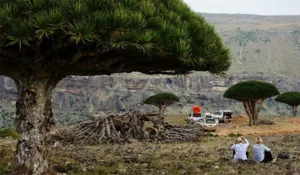Discover the most beautiful Island in the world Socotra Island – the most wonderful and unique corner of the world.
About Socotra Island
Socotra Island: Socotra Island is the largest of the four islands in the Socotra Archipelago, located in the Indian Ocean. The archipelago, part of the Republic of Yemen, includes Socotra Island, Abd al Kuri, Samhah, and Darsa, along with two rocky islets, Kaul Farawn and Sābūnīyah.
Geography: Situated on the southern coast of the Arabian Peninsula, where the Indian Ocean meets the Arabian Sea, east of the Gulf of Aden and the Horn of Africa. Socotra is approximately 300 km from the Yemeni coast and 900 km from Aden. It spans 125 km in length, 42 km in width, and has a 300 km coastline.
Unique Features: Socotra Island is renowned for its unique biodiversity and isolated ecosystems, often referred to as the “Galápagos of the Indian Ocean.” Its flora includes endemic species like the Dragon’s Blood Tree and the Socotra Desert Rose.
Climate and Environment: The island experiences a tropical desert climate with hot, dry conditions and seasonal monsoon winds. The diverse landscape includes limestone plateaus, rugged mountains, and pristine beaches.
Cultural and Ecological Significance: The Soqotri people inhabit Socotra Island, speaking the unique Soqotri language. The island’s isolated environment contributes to its exceptional ecological value and biodiversity, making it a significant site for conservation and ecotourism. Learn more

Abdul Kuri Island
Abdul Kuri Island: 120 kilometres from Socotra Island, Abdul Kuri Island is considered the second largest island in the archipelago.
While its area is estimated at 133 square kilometres, and its population exceeds 1,000 people, the people of Abdul Kuri also speak a dialect of the Socotra language, but it differs greatly from the dialects spoken by the people of the mother island of Socotra.
Samha Island
Samha Island: It is one of the islands of the Socotra Archipelago, and it is the smallest inhabited island of the archipelago. Its area is 40 square kilometres.
More than 200 people live on the island, and the people of the island depend on fishing and sheep herding.
The highest peak on the island reaches about 426 meters above sea level. It is also located next to the uninhabited island of Darsa.
Historically, the island’s strategic location made it the target of the invaders’ ambitions. Many invaders decided to occupy.
Darsa Island
Darsa Island: it is also one of the islands belonging to the Socotra Archipelago, about 20 kilometres away from Socotra Island. But unfortunately the island is uninhabited.
The island is characterized by stunning nature, charming clean beaches, and an attractive marine environment.





The Area of Socotra
The area of Socotra Island is about 3,650 square kilometers, from Ras Momi, which is the farthest east, to Ras Shu’ab, the farthest west, 135 km, while the maximum extension between north and south reaches 42 km
- The capital of the island is Hadibo, and the population of the island is about forty-four thousand and one hundred and twenty ( 44, 120 ) people.
Local inhabitants
The local residents of Socotra have their own language, lifestyle and their culture
Local population of Socotra Island: Statistics show that the number of local residents of Socotra Island ranges between forty-four thousand and one hundred and twenty ( 44, 120 ). Most of the inhabitants of Socotra live on the main island of the archipelago, specifically in the main city, Hadibo. The other islands are either sparsely inhabited or uninhabited. All of them speak Socotri language which is different language from the mainland and never been spoken anywhere else except the Socotri people.
Jobs and crafts practiced by the people of the island: Socotra Island is distinguished by the diversity of its economic activities, as a large portion of its population works in the field of fishing, and it has a large fish reserve, and there is palm cultivation, which contains more than 25 types of dates. The population widely practices the profession of herding in the mountains and plateaus, which has provided a large livestock wealth on the island.
One of the most prominent aspects of Soqotri culture is their traditional way of life, which is focused on fishing, farming, and livestock herding. Many Soqotris live in small villages throughout the island, and rely on the land and sea for their live hoods. in spite of all of that

Traditional Bedouin Culture
Socotra is also home to a vibrant Bedouin culture, with communities that have maintained their traditional way of life for centuries. Interact with the friendly locals, learn about their customs, and sample authentic Yemeni cuisine. Welcoming island residents will enhance your experience and provide valuable insights into the history and heritage of this unique destination
still the majority of the local inhabitants maintain on their original socotri culture. first of all original socotri language. it is an ancient unwritten language of pre-Islamic origin, and including traditional conservation techniques , natural medicine, fishing methods and orientation at the sea.

